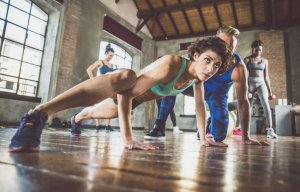Food and Functional Training

Although this type of exercise has always been around, it wasn’t given much importance until recently. In the following article, we’ll see how you can combine two great tools for a healthy body: food and functional training.
Functional training consists of performing exercises that our muscles carry out on a daily basis. Its purpose is to seek gradual progress of strength and endurance, respecting the natural movement of the body.
History of functional training
Functional training emerged as a rehabilitation method. During the eighties, Michael Boyle rescued this pre-existing knowledge and combined it with his experience as a trainer and with the teachings of the physiotherapist and world leader in biomechanics, Stuart McGill.
Later, Boyle published a book that would consolidate him as a reference for these exercises: Functional Training for Sports (2004).
Benefits
Functional exercises are designed to minimize injuries from falls and overuse of the muscles by strenuous repetitive actions. For example, they’re for people who work sitting in front of a screen or for someone who can do it standing up, facing the public.
There’s a multitude of tools that can help you improve the quality of your daily movements; this is precisely what this new fitness trend is all about: enhancing your physical fitness to facilitate day-to-day actions, such as climbing stairs or carrying shopping bags. Also, as we’ve mentioned, it can be helpful when you’re recovering from an injury too.
Examples of functional exercises
To cite a particular case, carpenters should pay special attention to their shoulders, elbows, and wrist joints. On the other hand, a forest ranger would need to focus more on aerobic resistance to strengthen their lower back and legs.

You could say that you can adapt functional training to any sport. It consists of working different parts of the body, seeking to emulate the patterns of movement that will be made in competitions.
This type of training is usually used in sports such as swimming, soccer, and tennis. It’s also used for training athletics.
Food and functional training
There’s no specific eating pattern for this type of exercise since it encompasses different sports. But what all sporting practices do have in common, though, is that the better the state of your health, the more optimal your performance.
Food and physical activity are two pillars of our well-being, and they almost always go hand in hand. It’s essential to exercise the whole body, combining exercises of strength and endurance. What’s the use of lifting 330 pounds in deadweight if you can’t run far or fast enough to catch the bus?
Something similar happens with food. There’s a widespread belief that if you exercise, you can eat unhealthy foods. For example, most people mistakenly think that you can eat a pizza and then go to a spinning class to “burn it off.”
In fact, different foods exert complex effects on our body; therefore, defending the previous concept is reductionist. In sports nutrition, what you eat before exercising is just as important as what you eat during and after.
Your diet before, during and after exercise
The main objectives of eating during training are:
- Satisfying the energy and nutrient requirements to keep up with the training program.
- Achieving a level of body mass, fat mass, and muscle mass that’s compatible with an optimal state of health and excellent performance.
- Improving adaptation and recovery between injuries.
The pre-workout meal is vital since your body has to optimize the levels of carbohydrate in the liver. Eating a banana before training is also a good option, and don’t forget to hydrate yourself well.

If you’re going to train for over an hour, you have to schedule breaks for yourself or eat carbohydrates and add replacement salts to your drink. If it’s less than an hour, as is usually the case with functional training, drinking water will suffice.
Once you’ve finished working out, your objective is to replace the water and the energy you’ve used. In this post-diet meal, avoid drinking anything carbonated or caffeine, as this puts your rehydration at risk. A piece of fruit will suffice if your next meal is due.
In any case, you must always assess the duration of the training, previous nutritional status, and weather conditions. It’s not the same to train outdoors in winter than in summer.
Food and functional training: conclusion
The main objective of functional training is to improve your physical condition for your everyday activities. Although you’ll never need to do a front squat at the supermarket, you may need to lift the milk cartons from the floor to the cart.
Sports must enhance each athlete’s psychical condition without injuring the body. In this sense, food is essential because it provides us with the necessary energy to carry-out our workouts.
Although this type of exercise has always been around, it wasn’t given much importance until recently. In the following article, we’ll see how you can combine two great tools for a healthy body: food and functional training.
Functional training consists of performing exercises that our muscles carry out on a daily basis. Its purpose is to seek gradual progress of strength and endurance, respecting the natural movement of the body.
History of functional training
Functional training emerged as a rehabilitation method. During the eighties, Michael Boyle rescued this pre-existing knowledge and combined it with his experience as a trainer and with the teachings of the physiotherapist and world leader in biomechanics, Stuart McGill.
Later, Boyle published a book that would consolidate him as a reference for these exercises: Functional Training for Sports (2004).
Benefits
Functional exercises are designed to minimize injuries from falls and overuse of the muscles by strenuous repetitive actions. For example, they’re for people who work sitting in front of a screen or for someone who can do it standing up, facing the public.
There’s a multitude of tools that can help you improve the quality of your daily movements; this is precisely what this new fitness trend is all about: enhancing your physical fitness to facilitate day-to-day actions, such as climbing stairs or carrying shopping bags. Also, as we’ve mentioned, it can be helpful when you’re recovering from an injury too.
Examples of functional exercises
To cite a particular case, carpenters should pay special attention to their shoulders, elbows, and wrist joints. On the other hand, a forest ranger would need to focus more on aerobic resistance to strengthen their lower back and legs.

You could say that you can adapt functional training to any sport. It consists of working different parts of the body, seeking to emulate the patterns of movement that will be made in competitions.
This type of training is usually used in sports such as swimming, soccer, and tennis. It’s also used for training athletics.
Food and functional training
There’s no specific eating pattern for this type of exercise since it encompasses different sports. But what all sporting practices do have in common, though, is that the better the state of your health, the more optimal your performance.
Food and physical activity are two pillars of our well-being, and they almost always go hand in hand. It’s essential to exercise the whole body, combining exercises of strength and endurance. What’s the use of lifting 330 pounds in deadweight if you can’t run far or fast enough to catch the bus?
Something similar happens with food. There’s a widespread belief that if you exercise, you can eat unhealthy foods. For example, most people mistakenly think that you can eat a pizza and then go to a spinning class to “burn it off.”
In fact, different foods exert complex effects on our body; therefore, defending the previous concept is reductionist. In sports nutrition, what you eat before exercising is just as important as what you eat during and after.
Your diet before, during and after exercise
The main objectives of eating during training are:
- Satisfying the energy and nutrient requirements to keep up with the training program.
- Achieving a level of body mass, fat mass, and muscle mass that’s compatible with an optimal state of health and excellent performance.
- Improving adaptation and recovery between injuries.
The pre-workout meal is vital since your body has to optimize the levels of carbohydrate in the liver. Eating a banana before training is also a good option, and don’t forget to hydrate yourself well.

If you’re going to train for over an hour, you have to schedule breaks for yourself or eat carbohydrates and add replacement salts to your drink. If it’s less than an hour, as is usually the case with functional training, drinking water will suffice.
Once you’ve finished working out, your objective is to replace the water and the energy you’ve used. In this post-diet meal, avoid drinking anything carbonated or caffeine, as this puts your rehydration at risk. A piece of fruit will suffice if your next meal is due.
In any case, you must always assess the duration of the training, previous nutritional status, and weather conditions. It’s not the same to train outdoors in winter than in summer.
Food and functional training: conclusion
The main objective of functional training is to improve your physical condition for your everyday activities. Although you’ll never need to do a front squat at the supermarket, you may need to lift the milk cartons from the floor to the cart.
Sports must enhance each athlete’s psychical condition without injuring the body. In this sense, food is essential because it provides us with the necessary energy to carry-out our workouts.
All cited sources were thoroughly reviewed by our team to ensure their quality, reliability, currency, and validity. The bibliography of this article was considered reliable and of academic or scientific accuracy.
- Dieguez J, Papí JD. Entrenamiento funcional en programas de fitness. Volumen I. Inde; 2006.
- Chulvi-Medrano I, Cortell-Tormo JM, González CSD. Consideraciones generales sobre el entrenamiento funcional. 2015
- Burke L. Nutrición En El Deporte: Un Enfoque Practico. Médica Panamericana; 2009.
This text is provided for informational purposes only and does not replace consultation with a professional. If in doubt, consult your specialist.








